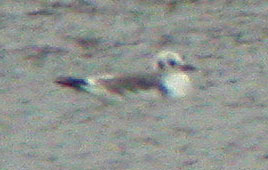 Black-legged Kittiwake (Rissa
tridactyla), Dryden Lake, Tompkins Co., NY, 16November 2002.
Black-legged Kittiwake (Rissa
tridactyla), Dryden Lake, Tompkins Co., NY, 16November 2002. Black-legged Kittiwake (Rissa
tridactyla), Dryden Lake, Tompkins Co., NY, 16November 2002.
Black-legged Kittiwake (Rissa
tridactyla), Dryden Lake, Tompkins Co., NY, 16November 2002.
All pictures are © Kevin and Jay McGowan. They were taken with an Olympus D-40 digital camera through a Swarovski HD-80 spotting scope.
While checking Dryden Lake, Tomkins Co., NY on a dreary Saturday, I was counting Ring-billed Gulls out in the middle of the lake to add into eBird. I noticed one individual that looked different. The birds were well out into the lake, and a fair amount of heat distortion was present. The odd gull had a slightly darker mantle than the surrounding Ring-billed Gulls, and longer, darker wingtips. I saw that it also had markings on the head, and at the base of the neck. When we looked closer we could see that it had a dark ear smudge and a distinct nuchal collar - 1st winter Black-legged Kittiwake (Rissa tridactyla)!
On the lake it was just slightly smaller than the Ring-bills, with a darker mantle, similarly rounded head, and all-dark bill. It had a prominent dark spot behind the dark eye, and a dark line where the neck met the back. It showed a thick dark line in the back half of the folded wing. The wingtips had no white in them. When scratching, it showed its black legs. In flight the dark "M" mark along the wings was quite apparent, along with the dark tip to the tail and white trailing edge to the wing. It had a faster wingbeat and more buoyant flight than the Ring-bills.
It sat with the other gulls for a while, but then drifted too close to a Herring Gull. The larger gull attempted to grab the kittiwake behind the head, and all the small gulls left the lake.After about 20 minutes it came back alone to the lake. (We think the Ring-bills landed in a nearby corn field and that the kittiwake thought that to be a stupid idea so it headed back to the water.) It circled the lake once, and then disappeared off to the northwest. It was not definitely seen again, but Ken Rosenberg saw an immature kittiwake on Cayuga Lake the next morning, possibly the same bird.
Black-legged Kittiwake is a relatively common bird in the marine waters of New York, and is nearly annual as scattered individual immatures along Lake Ontario and at the Niagara River. Occurrences away from the Atlantic or the Great Lakes are rare. Bull's Birds of New York State yielded only two upstate records away from the Great Lakes: one on Seneca Lake (Geneva) 31 Dec 1968 (Pepper Trail), and one at Iroquois NWR 21 Feb 1981. The species is on the list of birds for the Cayuga Lake Basin, but based only on vague reports from the late 1800's.
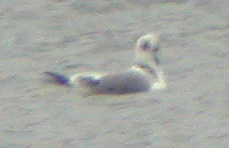 |
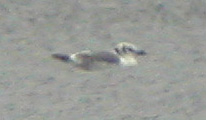 |
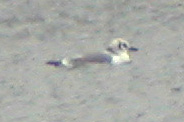 |
|
|
|
|
|
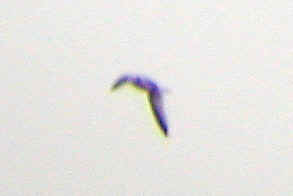 |
This is the only shot we got of it flying (through binoculars). The bird is headed left, and the dark wingstripe is apparent. Note too that the trailing edge of the wing is white, and that the triangle formed by the dark line is uniformly white. |
Back to the Wild November Weekend
Return to the Bad Photos page.
Return to Kevin McGowan's home page.
Go to the Crow Page.
Go to the Cornell Lab of Ornithology's home page